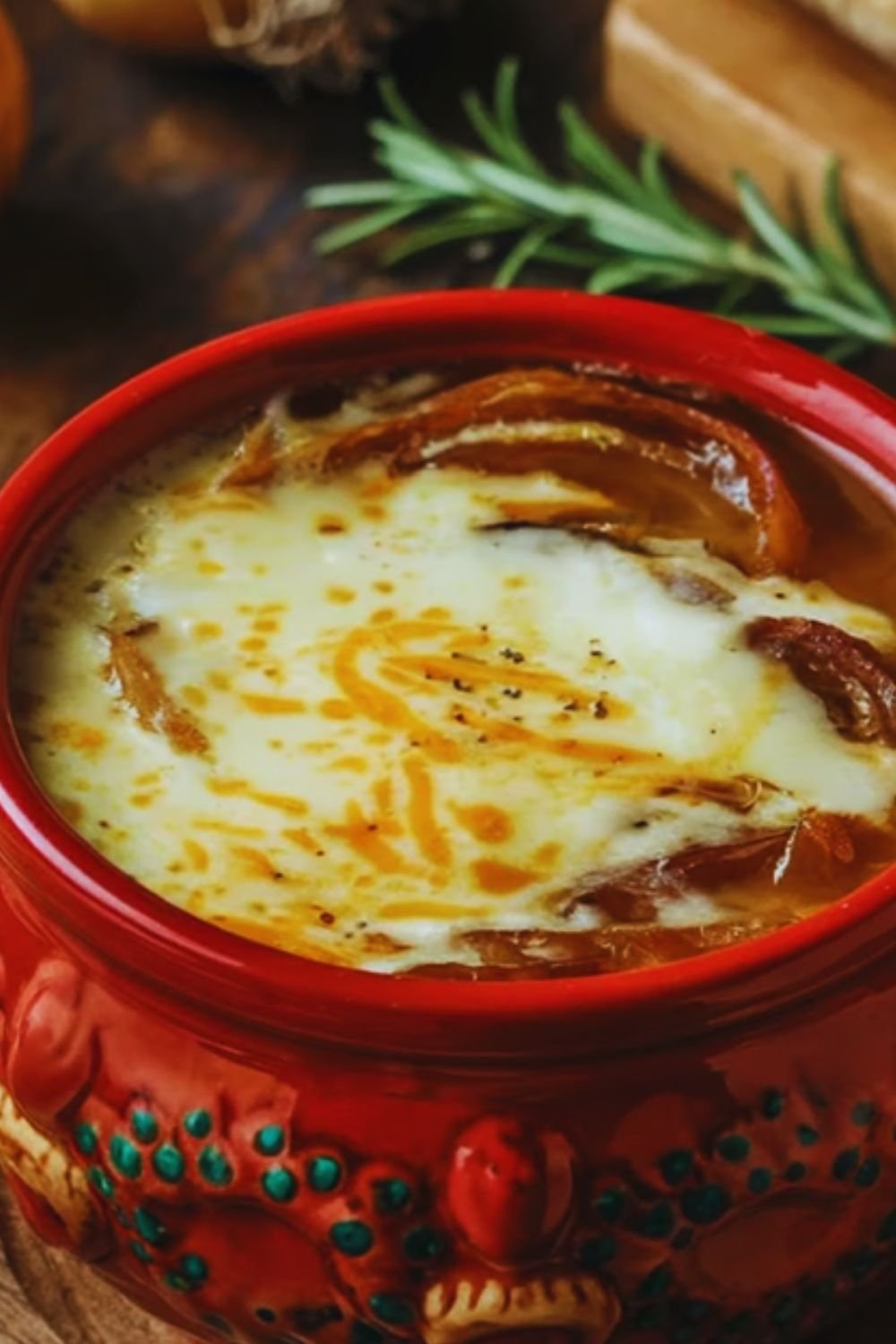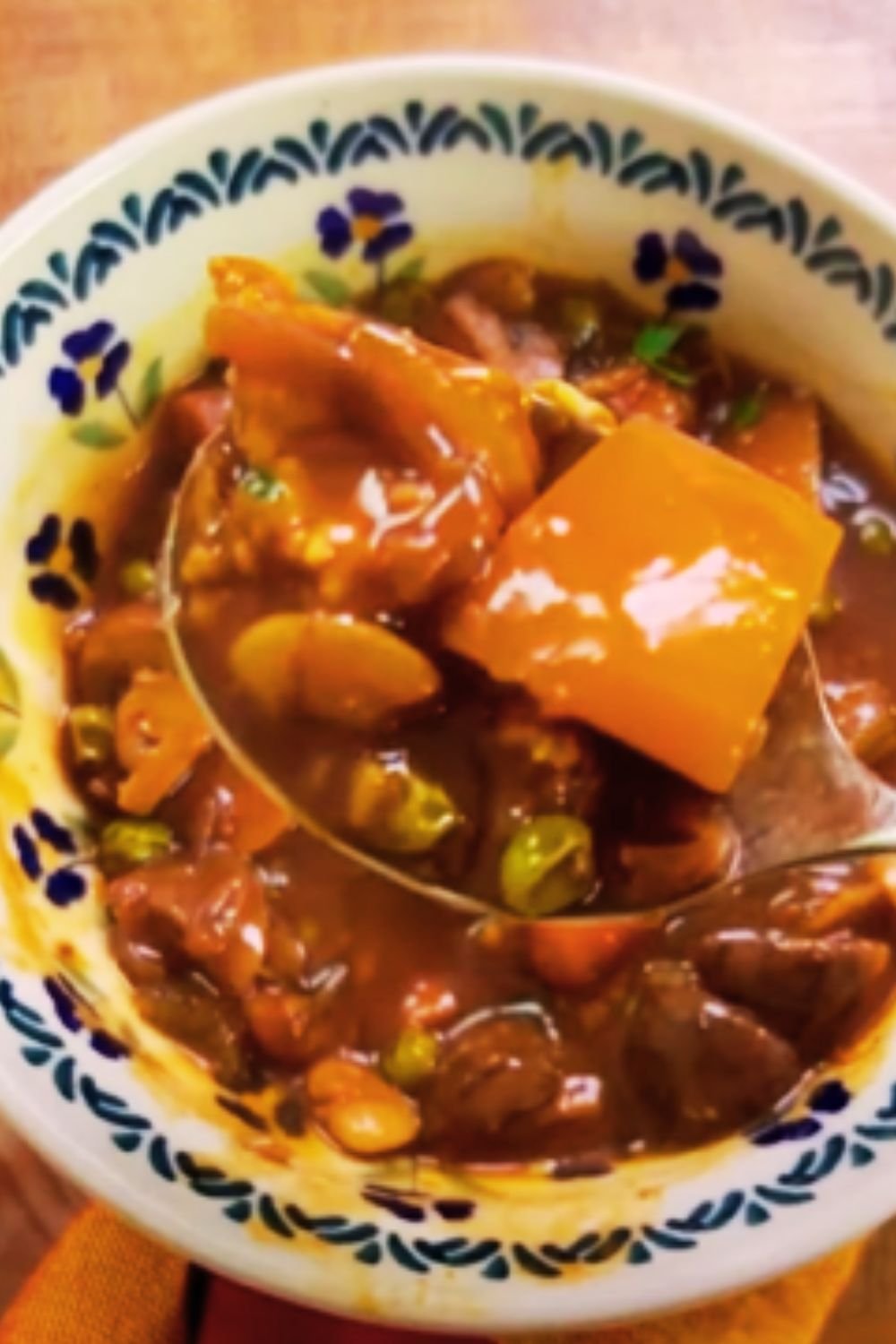There’s something magical about the moment when a spoonful of French onion soup breaks through that golden, bubbling layer of cheese to reveal the rich, caramelized goodness beneath. I’ve spent years perfecting my technique for this timeless classic, and today I’m sharing all my secrets for creating the most flavorful, authentic French onion soup you’ve ever tasted.
The Rich History Behind Every Spoonful
The humble origins of French onion soup date back to Roman times, but the version we know and love today gained popularity in 18th-century Paris. Originally a peasant dish created to make use of abundant, inexpensive onions, it was often enjoyed as a late-night meal by market workers at Les Halles, Paris’s central market district.
What began as simple sustenance has evolved into one of the most beloved dishes in French cuisine. I remember my first experience with authentic French onion soup in a tiny bistro tucked away on a rainy Parisian street. The rich aroma, the perfectly caramelized onions, and that irresistible gruyère crust created an unforgettable culinary memory that I’ve been trying to recreate ever since.
Why Mastering This Recipe Matters
French onion soup may seem straightforward, but achieving that perfect balance of sweet, savory, and umami flavors requires attention to detail. Many home cooks rush the caramelization process or use shortcuts that compromise the depth of flavor that makes this soup truly exceptional.
I’ve tested countless variations over the years, adjusting cooking times, experimenting with different onion varieties, and fine-tuning the broth composition. The recipe I’m sharing today represents the culmination of this culinary journey—a method that honors tradition while incorporating techniques that ensure consistent, restaurant-quality results in your home kitchen.
Essential Ingredients: Building Blocks of Flavor
The Onion Selection
The star ingredient deserves careful consideration. While yellow onions are traditional and my go-to choice, I’ve discovered that a blend of onion varieties creates unparalleled complexity:
- Yellow onions: Provide the classic sweet foundation (70% of your onion mix)
- White onions: Add sharpness and texture (20% of your onion mix)
- Shallots: Contribute a delicate, aromatic quality (10% of your onion mix)
For a standard pot serving 6 people, I use approximately 2.5 pounds of onions total. The exact ratio isn’t critical, but this blend creates a symphony of flavors that a single variety simply cannot achieve.
The Supporting Cast
Beyond onions, several key ingredients work together to create an authentic French onion soup:
Beef Stock : The backbone of your soup. Homemade is ideal, but a high-quality, low-sodium store-bought version can work well. I prefer stocks with minimal additives for a cleaner flavor.
Dry White Wine : Adds acidity and depth. Choose something you’d actually drink—a crisp Sauvignon Blanc or unoaked Chardonnay works beautifully.
Fresh Thyme : Provides an earthy, aromatic element that complements the sweetness of the onions.
Bay Leaves : Contribute subtle complexity and depth to the broth.
Gruyère Cheese : The traditional choice for its excellent melting properties and nutty flavor. Emmental or a combination of Gruyère and Comté are also excellent options.
Crusty Bread : French baguette is classic, but sourdough can offer a delightful tang.
Butter and Olive Oil : Using both provides the perfect balance of flavor and cooking properties.
Equipment Essentials
Having the right tools makes all the difference:
- Heavy-bottomed Dutch oven or soup pot: Essential for even heat distribution during the lengthy caramelization process
- Wooden spoon: Best for scraping up those flavorful browned bits from the pot bottom
- Oven-safe soup crocks: For that authentic presentation and proper cheese melting
- Mandoline slicer (optional): For achieving consistent onion slices, though a sharp knife works well too

The Step-by-Step Process
Phase 1: The Art of Caramelization
The soul of French onion soup lies in properly caramelized onions. This process cannot be rushed and typically takes 45-60 minutes. Here’s my foolproof method:
- Slice all onions thinly and uniformly (about 1/8 inch thick)
- Melt 3 tablespoons of butter with 1 tablespoon of olive oil in your Dutch oven over medium heat
- Add all onions at once, along with 1 teaspoon of salt (this helps draw out moisture)
- Cook for 10 minutes, stirring occasionally, until onions begin to soften and become translucent
- Reduce heat to medium-low and continue cooking for 30-45 minutes, stirring every few minutes to prevent burning
- When onions reach a deep golden brown color, add 1 tablespoon of flour and cook for 2-3 minutes (this will help thicken the soup slightly)
- Deglaze with 1/2 cup of dry white wine, scraping up all browned bits from the bottom of the pot
The caramelization process transforms the sharp, pungent raw onions into sweet, mellow morsels of flavor. The natural sugars break down, creating complex compounds that give the soup its characteristic richness.
Phase 2: Building the Broth
Once your onions are perfectly caramelized, it’s time to build the soup:
- Add 6 cups of beef stock, 3 sprigs of fresh thyme, and 2 bay leaves
- Bring to a gentle simmer and cook, uncovered, for 20-30 minutes to allow flavors to meld
- Season with fresh ground black pepper and additional salt if needed (taste first!)
- Remove and discard thyme sprigs and bay leaves before serving
Phase 3: The Crowning Glory
The iconic cheese crust that tops French onion soup requires a few special considerations:
- Preheat your broiler to high
- Ladle the hot soup into oven-safe crocks, filling to about 1/2 inch from the top
- Place 1-2 slices of toasted baguette on top of each soup portion
- Cover generously with grated Gruyère cheese (about 1/3 cup per serving)
- Place crocks on a baking sheet and broil for 3-5 minutes until cheese is melted, bubbly, and beginning to brown
The contrast between the crispy, cheesy top and the rich soup beneath creates the textural magic that makes this dish so beloved.
Comparative Analysis: Traditional vs. Modern Techniques
Over generations, certain variations in technique have emerged. Here’s how they stack up:
| Aspect | Traditional Method | Modern Adaptation | My Recommendation |
|---|---|---|---|
| Onion Caramelization | Low and slow (60+ minutes) | Addition of baking soda or sugar to speed process | Traditional approach; no shortcuts for authentic flavor |
| Broth Base | Homemade beef stock | Combination of beef and chicken stock for complexity | Homemade beef stock if possible, or 50/50 blend of high-quality store-bought beef and chicken stocks |
| Wine Component | Dry sherry | Dry white wine | Dry white wine for acidity; sherry tends to overpower other flavors |
| Cheese Topping | Gruyère only | Mixture of cheeses (Gruyère, mozzarella, Parmesan) | Predominantly Gruyère with a small amount of Parmesan for complexity |
| Bread Selection | Plain baguette | Garlic-rubbed, pre-toasted bread | Lightly toasted baguette brushed with olive oil for ideal texture |
| Additional Ingredients | None beyond the basics | Addition of cognac, mushrooms, or garlic | Minimal additions; a splash of cognac can add depth without compromising authenticity |
Troubleshooting Common Issues
Even experienced cooks occasionally encounter challenges with French onion soup. Here are solutions to the most common problems:
Issue: Onions burning instead of caramelizing
Solution: Lower heat and add a small amount of water (1-2 tablespoons) if the pot becomes too dry. Stir more frequently during the later stages of caramelization.
Issue: Soup lacks depth of flavor
Solution: Ensure proper caramelization of onions. Consider adding 1 teaspoon of concentrated beef base or a small splash of Worcestershire sauce for additional umami.
Issue: Cheese forms a solid “cap” that’s difficult to eat
Solution: Use a coarser grate on your cheese and ensure your soup is very hot when adding the cheese and bread. Alternatively, place the bread first, then cheese, so some cheese melts into the soup.
Issue: Bread becomes too soggy
Solution: Toast the bread more thoroughly before adding it to the soup, or place it on top just before adding the cheese and broiling.

Serving Suggestions
French onion soup makes a marvelous starter, but I often enjoy it as a main course on chilly evenings. Here are some ideal accompaniments:
- A crisp green salad with a light vinaigrette to cut through the richness
- Fresh baguette with unsalted butter for dipping
- A sparkling water with lemon to cleanse the palate
For a more substantial meal, consider serving:
- A simple roasted chicken with herbs
- Pan-seared scallops as an elegant starter before the soup
- Steamed asparagus or haricots verts with a touch of lemon zest
Make-Ahead and Storage Guidelines
One of the many virtues of French onion soup is how well it keeps. In fact, I find the flavor improves after a day in the refrigerator. Here’s how to make the most of leftovers:
- The soup base (without bread and cheese) can be refrigerated for up to 4 days
- For longer storage, freeze the soup base for up to 3 months
- Always reheat thoroughly before adding the bread and cheese toppings
- For best results, bring refrigerated soup to room temperature before reheating
Seasonal and Regional Variations
While the classic recipe remains beloved, French onion soup adapts beautifully to seasonal ingredients and regional preferences:
Spring Variation
Lighten the soup with a blend of spring onions and leeks, using a combination of beef and vegetable stock for a less robust profile.
Alsatian Influence
In this eastern French region bordering Germany, you’ll often find the addition of a local white wine and sometimes a small amount of sauerkraut mixed with the onions.
Provence Twist
Add a touch of herbes de Provence and use olive oil exclusively instead of butter for a Mediterranean take.

The Complete Recipe
Now that we’ve explored the nuances, here’s the complete recipe for my ultimate French onion soup:
Ingredients (Serves 6)
- 2 pounds yellow onions, thinly sliced
- 1/2 pound white onions, thinly sliced
- 1/4 pound shallots, thinly sliced
- 3 tablespoons unsalted butter
- 1 tablespoon olive oil
- 1 teaspoon kosher salt
- 1 tablespoon all-purpose flour
- 1/2 cup dry white wine
- 6 cups high-quality beef stock
- 3 sprigs fresh thyme
- 2 bay leaves
- Freshly ground black pepper, to taste
- 1 baguette, sliced into 1/2-inch rounds and toasted
- 12 ounces Gruyère cheese, grated (about 3 cups)
- 2 tablespoons grated Parmesan cheese (optional)
Instructions
- In a large Dutch oven, melt butter with olive oil over medium heat
- Add all sliced onions and shallots, sprinkle with salt, and stir to coat
- Cook for 10 minutes, stirring occasionally, until onions begin to soften
- Reduce heat to medium-low and continue cooking for 40-50 minutes, stirring every few minutes, until onions reach a deep golden brown color
- Sprinkle flour over onions and cook for 2-3 minutes, stirring constantly
- Add white wine to deglaze the pot, scraping up browned bits from the bottom
- Add beef stock, thyme sprigs, and bay leaves
- Bring to a simmer and cook, uncovered, for 25-30 minutes
- Remove thyme and bay leaves, then taste and adjust seasoning with salt and pepper
- Preheat broiler to high
- Ladle soup into oven-safe crocks
- Place 1-2 slices of toasted baguette on top of each soup portion
- Generously cover with grated Gruyère and a sprinkle of Parmesan if using
- Place crocks on a baking sheet and broil for 3-5 minutes until cheese is melted, bubbly, and beginning to brown
- Allow to cool slightly before serving (the bowls will be extremely hot!)
Nutritional Information
For those monitoring dietary intake, here’s the approximate nutritional breakdown per serving (excluding the bread and cheese topping):
| Nutrient | Amount per Serving |
|---|---|
| Calories | 185 |
| Total Fat | 9g |
| Saturated Fat | 4g |
| Cholesterol | 18mg |
| Sodium | 780mg |
| Total Carbohydrates | 17g |
| Dietary Fiber | 3g |
| Sugars | 8g |
| Protein | 7g |
With the bread and cheese topping, add approximately 200-250 calories per serving.
Expert Tips from My Kitchen to Yours
After years of perfecting this recipe, I’ve gathered several insights that can elevate your French onion soup from good to exceptional:
- Don’t rush the caramelization: This is where the magic happens. Those 45+ minutes transform simple onions into complex, sweet umami bombs.
- Cut onions pole-to-pole: Slicing from root to stem (rather than across the equator) helps onions maintain their structure during long cooking.
- Keep scraping the fond: Those browned bits that stick to the pot bottom contain concentrated flavor. Periodically deglaze with small amounts of water if needed.
- Use room-temperature cheese: It melts more evenly than cold cheese, creating that perfect golden crust.
- Let the finished soup rest: Allow 5 minutes between removing from the broiler and serving to let flavors settle and prevent burned mouths.
Frequently Asked Questions
Q: Can I make French onion soup vegetarian? The classic version relies on beef stock for its depth of flavor, but you can create a delicious vegetarian version using a robust vegetable stock. Add dried porcini mushrooms (rehydrated, then strained) to the stock for increased umami. Soy sauce or mushroom-based umami seasoning (1-2 teaspoons) can also add depth.
Q: How critical is the cheese selection? Gruyère is traditional for good reason—it has the perfect balance of flavor and meltability. However, Emmental, Comté, or even a good Swiss cheese can work well. Avoid pre-shredded cheese as it contains anti-caking agents that affect melting.
Q: My onions won’t caramelize properly. What am I doing wrong? The most common issues are overcrowding the pot, cooking at too high a temperature, or not cooking long enough. Make sure your pot is large enough for the onions to have some breathing room, maintain a medium-low heat, and be patient—proper caramelization takes time.
Q: Can I make this soup in advance for a dinner party? Absolutely! In fact, I recommend it. Make the soup base up to three days ahead and refrigerate. Simply reheat before adding the bread and cheese toppings just before serving.
Q: Is there a way to speed up the onion caramelization process? While some recipes suggest adding a pinch of baking soda or sugar to speed caramelization, I don’t recommend these shortcuts. The slow caramelization process develops complex flavors that can’t be rushed. However, you can caramelize a large batch of onions in advance and freeze them in portions for future use.
Q: How do I prevent tears when slicing so many onions? I’ve found that chilling onions for 30 minutes before slicing reduces tear-inducing compounds. Using a very sharp knife also helps, as it damages fewer cells during cutting. Some swear by wearing swimming goggles, which I’ve tried in desperate moments—slightly ridiculous looking but surprisingly effective!
Final Thoughts: Why This Recipe Works
Creating truly exceptional French onion soup is less about fancy techniques and more about honoring the process. The magic happens in the patient transformation of humble ingredients into something extraordinary.
I believe what sets this recipe apart is the attention to detail—using a blend of onions for complexity, taking the time to develop proper caramelization, and balancing the rich beef broth with a touch of acidity from the wine. The result is a soup with remarkable depth that satisfies on multiple levels.
Whether you’re making this as an impressive starter for a dinner party or a comforting meal on a chilly evening, this recipe delivers consistent, restaurant-quality results. The aromas that fill your kitchen during preparation are an added bonus—few cooking projects create such an inviting atmosphere.
I hope you enjoy this French onion soup as much as I’ve enjoyed perfecting it over the years. There’s something deeply satisfying about maintaining culinary traditions that have brought comfort to generations, especially when the results are this delicious.


